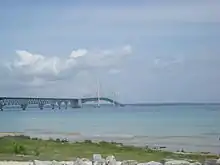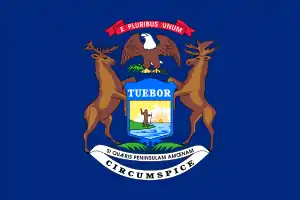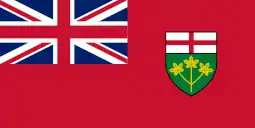Enbridge Line 5
Enbridge Line 5 is a major oil pipeline in the Enbridge Lakehead System, which conveys petroleum from western Canada to eastern Canada via the Great Lakes states. Line 5 is particularly notable for passing under the environmentally sensitive Straits of Mackinac, which connect Lake Michigan to Lake Huron. As of December 2013,[1] the line carries 540,000 barrels (86,000 m3) of oil per day. It carries synthetic crude, natural gas liquids, sweet crude, and light sour crude.[2]
| Enbridge Line 5 | |
|---|---|
 Straits of Mackinac | |
| Location | |
| Country | United States, Canada |
| State | Wisconsin, Michigan |
| From | Superior, Wisconsin |
| To | Sarnia, Ontario |
| General information | |
| Type | oil |
| Owner | Enbridge |
| Commissioned | 1953 |
| Technical information | |
| Length | 645 mi (1,038 km) |
| Diameter | 30 in (762 mm) |
Route
The pipeline runs between two major nodes of the Enbridge Pipeline System at Superior, Wisconsin, and Sarnia, Ontario. The Enbridge terminal at Superior conveys western Canadian crude oil from various incoming pipelines (including lines 1–4) to Line 5 and Line 6, which go around the northern and southern shores of Lake Michigan respectively.
From Superior, Line 5 travels east to the Upper Peninsula of Michigan, then runs southeast to Rapid River, near Escanaba.[3] At Rapid River, natural gas liquids (NGL) are side stream delivered for stripping, and the stripped NGLs are reinjected.[4]
From Rapid River, the pipeline runs near the northern shore of Lake Michigan until it reaches the Straits of Mackinac. There the pipeline divides into two separate 20-inch (51 cm) lines, which reunite when they reach McGulpin Point on the southern side of the straits.[4] The lines are buried until they reach a depth of 65 feet (20 m).[5] The lines descend to a depth of approximately 270 feet (82 m) under the straits.[6]
Once on land again in the Lower Peninsula, Line 5 runs near Interstate 75 to Bay City.[7] At the Lewiston pumping station, US sweet crude may be injected.[4] From Lewiston, Line 5 loops around Saginaw Bay, then runs southeast to the St. Clair River.[3]
Just before the St. Clair River, Line 5 reaches the Marysville pumping station. Volumes destined for Michigan and Ohio refineries such as BP Husky and Marathon Detroit are offloaded there,[4] and transferred to a Sunoco pipeline that runs from Marysville to Toledo.[8][9]
The line then proceeds east across the St. Clair River to Ontario, where it rejoins Enbridge Line 6 and terminates at Sarnia.[2] Any volumes not destined for Sarnia-area refineries are then pumped into tanks for transfer to Enbridge Line 7.[4]
History

Construction on Line 5 was completed in 1953.[6] The pipelines from western Canada to Superior had been completed in 1950; prior to the construction of Line 5, the crude oil was conveyed from Superior to southern Ontario by oil tankers.[10]
In 2013, the line's capacity was increased by 50,000 barrels (7,900 m3) per day, from 490,000 to 540,000 barrels (78,000 to 86,000 m3).[11] The upgrade involved US$100 million in improvements to pumping stations, but no change to the actual pipes.[7]
In 2018, a tugboat anchor hit the pipeline and caused minor damage to the pipe.[12]
Also in 2018, Enbridge and the State of Michigan agreed to build a tunnel beneath the Straits of Mackinac that will contain the pipeline.[13]
In 2020, as part of Enbridge’s seasonal maintenance work on Line 5 in the Straits, a screw anchor support was found to have shifted from its original position. This affected the anchor support and not the pipeline itself. On June 20, 2020, Enbridge reported that on Friday, June 19, 2020, its Remote Operated Vehicle (ROV) inspection was completed of the west leg of Line 5 in the Straits and confirmed there were no issues or damage to the anchor structures or pipeline on the west leg.
Line 5 in the Straits consists of two 20-inch pipelines, an east leg and a west leg, running parallel to each other for the 4.5 miles across the lakebed.
The issue with the screw anchor assembly observed on Thursday, June 18, 2020, was isolated to the east leg, which is under continuing investigation and evaluation over the weekend.
As the west leg was not affected, normal operations resumed on that line on Saturday, June 20, 2020, at approximately 2 PM Eastern Time. The east leg was to remain shut down. The federal regulator, Pipeline and Hazardous Materials Safety Administration (PHMSA), had no objections to the plan.
Enbridge CEO Al Monaco responded to Michigan Governor Gretchen Whitmer to confirm that Enbridge was committed to sharing what is learned about the incident with the screw anchor assembly on the east leg with PHMSA and the State of Michigan. This event was 5 days after latest ruling by the U.S. Sixth Circuit Court of Appeals that cited the emergency response for the pipeline adequate to protect wildlife in the Straits of Mackinac. The pipeline connects Superior, WI, with Sarnia, in the Ontario province of Canada.
"The controversial project has faced fierce opposition from many conservationists, environmentalists and several Tribal Authorities as a rupture in the pipeline in such a critical area can result in loss of endangered species. The underwater segment is 67-year old and consists of two pipes. The company stated that the pipeline is in a good condition even though the outer coating has worn away in some places and steel braces are placed at places hit by erosion. The company expects a tunnel would provide sufficient safety for the pipeline to remain operational under water.
"Enbridge intends to commence work on the tunnel once it receives all the necessary permits. Construction of the tunnel is expected to be completed in 2024. Line 5 is a 30-inch 645-mile pipeline."
Mackinac Straits Corridor Authority (MSCA) agreement
On December 19, 2018 the Michigan Department of Natural Resources announced that the Mackinac Straits Corridor Authority (MSCA), in correspondence with outgoing Governor Rick Snyder, approved an agreement to build a multi-purpose tunnel that will house multiple utility lines. In addition, the old Enbridge Line 5 will be removed & a new line will be constructed. Within the agreement the MSCA approved the transfer of a property right, which allows Enbridge to construct the new tunnel in bedrock beneath the Straits of Mackinac.[14]
Controversies
The 2013 expansion, coupled with the anticipated expansion of the Alberta Clipper pipeline, led to concerns from the National Wildlife Federation and other groups over the possible shipment of diluted bitumen from the Alberta tar sands through Line 5.[15] However, Enbridge has denied any plans to pump such materials. Line 5 ships nearly 23 million gallons of crude oil and petroleum products every day.[16] A 2011 toll agreement describes the materials as "condensate, light synthetic, sweet, light sour and NGL,"[4] as does a 2013 summary of the Mainline System.[2] Due to national security concerns, however, the Pipeline and Hazardous Materials Safety Administration does not divulge the materials actually carried on major US pipelines, including Line 5.[15]
Public concerns have particularly focused on the risk of a spill under the Straits of Mackinac, and the difficulty of controlling any spill that might occur.[6][11] According to Enbridge, the pipes under the straits have never leaked, are monitored 24 hours a day, and are regularly inspected by underwater autonomous vehicles.[5][6] However, there have been numerous spills elsewhere in Michigan from Enbridge pipelines, including a major Line 5 spill at Crystal Falls in 1999, as well as the 2010 Kalamazoo River oil spill on Line 6.[6][15]
In 2014, it was found that Enbridge was not complying with the spacing requirement for supporting anchors for the pipeline; anchors should be placed at least every 75 feet.[17] In a statement, Michigan Attorney General, Bill Schuette, requested Enbridge to comply with the anchor support regulations, "We will insist that Enbridge fully comply with the conditions of the Straits Pipeline Easement to protect our precious environmental and economic resources and limit the risk of disaster threatening our waters." [17]
By the end of 2015, eight Michigan counties or municipalities were calling for the retirement of Line 5 including Cheboygan, Cheboygan County, Emmet County, Genesee County, Mackinaw City, Mentor Township, Munising Township, and Wayne County.[18]
According to a study published by the University of Michigan, in partnership with the National Oceanic and Atmospheric Administration, a leak in Enbridge 5 near the Straits of Mackinac could affect roughly 700 miles of shoreline.[19] Key areas recognized for the highest potential risk include Mackinac Island, Bois Blanc Island, Mackinaw City, and areas on the northern shore and southern shore of the Straits. The study found that 3,528 square miles (15%) of Lake Michigan's open water and roughly 13,611 square miles (60%) of Lake Huron's open water could be impacted by visible oil.[19][20] In addition, highly turbulent flowing currents found within the Straits of Mackinac, combined with the degrading enzymes secreted by zebra mussels, and aging pipe welds and coal tar enamel, increases the risk for corrosion and potential fissures to occur in the pipes.[21][22][19] Due to these issues, expert reports concluded that Line 5 should be shut down in the Straits pending a full review under state public trust law.[23] Although the U of M study showcased worst case scenarios, experts recommend completing a risk analysis that includes, "1) analysis of environmental impacts, 2) cleanup costs, 3) restoration and remediation measures, 4) a natural resource damage assessment, and 5) Economic damage to public and private sector interests."[19]
2019 lawsuit
In late June 2019, the state of Michigan filed a lawsuit asking the Ingham County Court to compel the decommissioning of the segment of Line 5 that runs under the Straits of Mackinac; the dual pipes, in use since 1953,[24] were then shipping 540,000 barrels of oil and propane per day. A Reuters news report defined Line 5 as "a critical part of Enbridge’s Mainline network, which delivers the bulk of Canadian crude exports to the United States". The basis of the suit is the claim that the pipeline is a public nuisance and violates the Michigan Environmental Protection Act since it may become the source of pollution. The news report adds that "it is unclear if Line 5 could operate without the Straits segment".[25]
Attorney General Dana Nessel made this comment: "We cannot prevent accidental or emergency anchor deployments in one of the busiest shipping channels in the Great Lakes. And it only takes one such incident to cause an environmental and economic catastrophe. That is a risk no one should be willing to take". Michigan Senate Republicans expressed concern about the potential shutdown of the pipeline. In their view, that move would create other problems, as reported by The Detroit News.[26]
"the loss of thousands of construction jobs expected from the tunnel construction, an increase in costs at Detroit and Toledo refineries and the loss of a significant mode of propane transportation in Michigan. It is estimated that replacing the propane lost by closing the line would require an additional 30,000 truckloads and 9,600 rail cars annually".
See also
 Energy portal
Energy portal Michigan portal
Michigan portal Ontario portal
Ontario portal Transport portal
Transport portal
References
- "2013 ENB Investment Community Booklet" (PDF). Enbridge. 2013. p. 25.
- "Pipeline System Configuration: Quarter 1, 2013". Enbridge. 2013. p. 1. Archived from the original on March 31, 2014.
- Enbridge Liquid Pipeline Map (PDF) (Map). Enbridge. 2012. Retrieved March 31, 2014.
- Enbridge Pipelines Inc. (July 1, 2011). "Competitive Toll Settlement" (PDF). p. 89. Retrieved March 30, 2014.
- "Line 5 Underwater Images". Enbridge. Retrieved March 31, 2014.
- Flesher, John (March 3, 2014). "Submerged Enbridge Pipeline Under Michigan's Straits of Mackinac Raises Spill Fears". The Huffington Post. Associated Press.
- Sherburne, Morgan (July 12, 2013). "Enbridge to Increase Oil Flow under Straits, Rally Planned". Petoskey News. Retrieved March 31, 2014.
- "Crude Oil Pipeline System". Sunoco. Retrieved April 1, 2014.
- Proposed Line 79 Pipeline Project (PDF) (Map). Enbridge. Retrieved April 1, 2014.
- Simonson, Mike (January 25, 2013). "Bakken Boom Has Calumet Considering Building Oil Loading Dock in Superior". BusinessNorth. Archived from the original on April 7, 2014.
- "Senators Stabenow and Levin Urge Transportation Department to Verify Safety of Enbridge Pipeline in Great Lakes" (Press release). Office of Debbie Stabenow. December 11, 2013. Retrieved March 31, 2014.
- "Enbridge: Damaged oil pipeline was dented less than 1 inch". The Associated Press. May 14, 2018.
- Kransz, Michael (October 3, 2018). "Enbridge will pay for Line 5 tunnel in Straits of Mackinac, state says". MLive. Retrieved October 5, 2018.
- Golder, Ed (December 19, 2018). "Mackinac Straits Corridor Authority approves multi-use tunnel agreement". Michigan Department of Natural Resources. Retrieved December 20, 2018.
- Leahy, Derek (March 6, 2014). "Concerns Mount About 61-Year Old Enbridge Pipeline in the Great Lakes". The Narwhal. Retrieved October 30, 2018.
- Ellison, Garret (October 22, 2014). "Environmental concerns trip up Enbridge oil pipeline project in Ontario". MLive.
- Klug, Fritz (July 24, 2014). "Enbridge pipeline in Straits of Mackinac needs more supports, Attorney General says". MLive. Retrieved November 8, 2017.
- Oil & Water Don't Mix (2015) "Local governments are issuing resolutions calling for the shutdown of the flow of oil in Line 5 at the Straits of Mackinac"
- Schwab, David (March 2016). "Statistical Analysis of Straits of Mackinac Line 5 Worst Case Spill Scenarios" (PDF). Graham Sustainability Institute at University of Michigan.
- Erickson, Jim (March 31, 2016). "More than 700 miles of Great Lakes shoreline potentially vulnerable to Straits of Mackinac oil spills". University of Michigan News.
- "Status and Strategy for Zebra and Quagga Mussel Management". Michigan.gov. Retrieved November 8, 2017.
- Lachman, Samantha (May 22, 2016). "This Aging Oil Pipeline Is In Great Lakes' 'Worst Possible Place' For A Spill". Huffpost. Retrieved November 8, 2017.
- "Experts Recommend Shutting Down Mackinac Straits Oil Lines". Graham Sustainability Institute News (published December 4, 2015). January 6, 2016.
- "Michigan sues to shut down Enbridge Line 5 pipeline in Great Lakes". Global News. June 27, 2019. Retrieved June 30, 2019.
Michigan’s attorney general sued Thursday to shut down twin 66-year-old oil pipelines in the Great Lakes, saying they pose an "unacceptable risk" and the state cannot wait five to 10 years for Enbridge Inc. to build a tunnel to house replacement pipes running through the Straits of Mackinac.
- "Michigan sues Enbridge to shut down Line 5 oil pipeline through Great Lakes". Financial Post. June 27, 2019. Retrieved June 30, 2019.
The location of the pipelines…combines great ecological sensitivity with exceptional vulnerability to anchor strikes," said Nessel in a statement. "This situation with Line 5 differs from other bodies of water where pipelines exist because the currents in the Straits of Mackinac are complex, variable, and remarkably fast and strong.
- https://www.detroitnews.com/story/news/local/michigan/2019/06/27/nessel-court-line-5-environment-risk-shutdown/1582536001/, Nessel to court: Shut down Line 5 as environmental risk